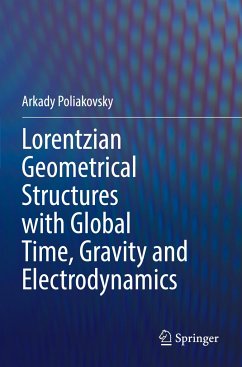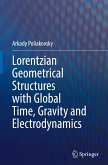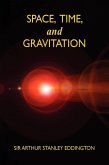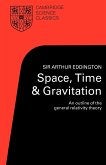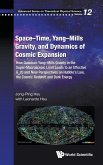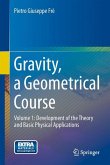Arkady Poliakovsky
Lorentzian Geometrical Structures with Global Time, Gravity and Electrodynamics
Arkady Poliakovsky
Lorentzian Geometrical Structures with Global Time, Gravity and Electrodynamics
- Broschiertes Buch
- Merkliste
- Auf die Merkliste
- Bewerten Bewerten
- Teilen
- Produkt teilen
- Produkterinnerung
- Produkterinnerung
This book investigates Lorentzian structures in the four-dimensional space-time, supplemented either by a covector field of the time-direction or by a scalar field of the global time. Furthermore, it proposes a new metrizable model of gravity. In contrast to the usual General Relativity theory, where all ten components of the symmetric pseudo-metric are independent variables, the gravity model presented here essentially depends only on a single four-covector field, and is restricted to have only three-independent components. However, the author proves that the gravitational field, governed by…mehr
Andere Kunden interessierten sich auch für
![Lorentzian Geometrical Structures with Global Time, Gravity and Electrodynamics Lorentzian Geometrical Structures with Global Time, Gravity and Electrodynamics]() Arkady PoliakovskyLorentzian Geometrical Structures with Global Time, Gravity and Electrodynamics95,99 €
Arkady PoliakovskyLorentzian Geometrical Structures with Global Time, Gravity and Electrodynamics95,99 €![Space, Time, and Gravitation Space, Time, and Gravitation]() Arthur Stanley EddingtonSpace, Time, and Gravitation27,99 €
Arthur Stanley EddingtonSpace, Time, and Gravitation27,99 €![Space, Time, and Gravitation Space, Time, and Gravitation]() Arthur Stanley EddingtonSpace, Time, and Gravitation57,99 €
Arthur Stanley EddingtonSpace, Time, and Gravitation57,99 €![SPACE-TIME, YANG-MILLS GRAVITY & DYNAMICS COSMIC EXPANSION SPACE-TIME, YANG-MILLS GRAVITY & DYNAMICS COSMIC EXPANSION]() Jong-Ping Hsu & Leonardo HsuSPACE-TIME, YANG-MILLS GRAVITY & DYNAMICS COSMIC EXPANSION131,99 €
Jong-Ping Hsu & Leonardo HsuSPACE-TIME, YANG-MILLS GRAVITY & DYNAMICS COSMIC EXPANSION131,99 €![Space, Time, and Gravitation Space, Time, and Gravitation]() Arthur Stanley EddingtonSpace, Time, and Gravitation18,99 €
Arthur Stanley EddingtonSpace, Time, and Gravitation18,99 €![Time, Temporality, Now Time, Temporality, Now]() Time, Temporality, Now37,99 €
Time, Temporality, Now37,99 €![Gravity, a Geometrical Course Gravity, a Geometrical Course]() Pietro Giuseppe FrèGravity, a Geometrical Course132,99 €
Pietro Giuseppe FrèGravity, a Geometrical Course132,99 €-
-
-
This book investigates Lorentzian structures in the four-dimensional space-time, supplemented either by a covector field of the time-direction or by a scalar field of the global time. Furthermore, it proposes a new metrizable model of gravity. In contrast to the usual General Relativity theory, where all ten components of the symmetric pseudo-metric are independent variables, the gravity model presented here essentially depends only on a single four-covector field, and is restricted to have only three-independent components. However, the author proves that the gravitational field, governed by the proposed model and generated by some massive body, resting and spherically symmetric in some coordinate system, is given by a pseudo-metric that coincides with the well known Schwarzschild metric from General Relativity. The Maxwell equations and electrodynamics are also investigated in the framework of the proposed model. Inparticular, the covariant formulation of electrodynamics ofmoving dielectrics and para/diamagnetic media is derived.
Produktdetails
- Produktdetails
- Verlag: Springer / Springer Nature Switzerland / Springer, Berlin
- Artikelnr. des Verlages: 978-3-031-23764-5
- 1st ed. 2023
- Seitenzahl: 200
- Erscheinungstermin: 7. Februar 2024
- Englisch
- Abmessung: 235mm x 155mm x 12mm
- Gewicht: 312g
- ISBN-13: 9783031237645
- ISBN-10: 3031237641
- Artikelnr.: 69775886
- Verlag: Springer / Springer Nature Switzerland / Springer, Berlin
- Artikelnr. des Verlages: 978-3-031-23764-5
- 1st ed. 2023
- Seitenzahl: 200
- Erscheinungstermin: 7. Februar 2024
- Englisch
- Abmessung: 235mm x 155mm x 12mm
- Gewicht: 312g
- ISBN-13: 9783031237645
- ISBN-10: 3031237641
- Artikelnr.: 69775886
Arkady Poliakovsky is Associate Professor at the Department of Mathematics at Ben-Gurion University of the Negev, Be'er Sheva, Israel. His main specialization is Calculus of Variations and Partial Differential Equations. However he is also interested in Physics, Mathematical Physics, Fluid Mechanics, Differential Geometry and Tensor Calculus. Born in Russia in 1978, he immigrated with his parents to Israel in 1993 and obtained all his academic degrees from the Department of Mathematics of the Technion - I.I.T., Haifa, Israel: his primary Bachelor degree (summa cum laude) in 1999, a M.Sc. degree in 2002, a Ph.D. in 2005. During the period 2005-2012 he held PostDoc positions in different universities: Paris VI, University of Zurich, University of Duisburg-Essen, University of Bonn, University of Rome - Tor Vergata. He was appointed to a Tenure Track position at Ben Gurion University of the Negev (Be'er Sheva, Israel) in 2012 ( Senior Lecturer till 2016, Associate Professor since 2016, tenured since 2017). He obtained secondary Bachelor degrees in Physics and Computer Science in Technion, Haifa at 2017.
1. Preliminary introduction.- 2. Basic definitions and statements of the main results.- 2.1. Generalized-Lorentz's structures with time-direction and global time.- 2.1.1. Pseudo-Lorentzian coordinate systems.- 2.2. Kinematical Lorentz's structure with global time.- 2.3. Kinematical and Dynamical generalized-Lorentz structures with time direction.- 2.4. Lagrangian of the motion of a classical point particle in a given pseudo-metric with time direction.- 2.5. Lagrangian of the electromagnetic field in a given pseudo-metric.- 2.6. Correlated pseudo-metrics.- 2.7. Kinematically correlated models of the genuine gravity.- 2.8. Lagrangian for dynamical time-direction and its limiting case.- 2.9 Lagrangian of the genuine gravity.- 3. Mass, charge and Lagrangian densities and currents of the system of classical point particles.- 4. The total simplified Lagrangian in (2.9.23), (2.9.24), for the limiting case of (2.9.20) in a cartesiancoordinate system.- 5. The Euler-Lagrange for the Lagrangian of the motion of a classical point particle in a cartesian coordinate system.- 6. The Euler-Lagrange for the Lagrangian of the gravitational and Electromagnetic fields in (4.0.71) in a cartesian coordinate system.- 6.1. The Euler-Lagrange for the Lagrangian in (4.1.71) in a cartesian coordinate system.- 7. Gravity field of spherically symmetric massive resting body in a coordinate system which is cartesian and inertial simultaneously.- 7.1. Certain curvilinear coordinate system in the case of stationary radially symmetric gravitational field and relation to the Schwarzschild metric.- 8. Newtonian gravity as an approximation of (6.0.52).- 8.1. Newtonian gravity as an approximation of (6.1.52).- 9. Polarization and magnetization.- 9.1 Polarization and magnetization in a cartesian coordinate system.- 10. Detailed proves of the stated Theorems, Propositions and Lemmas.- 11. Appendix: sometechnical statements.
1. Preliminary introduction.- 2. Basic definitions and statements of the main results.- 2.1. Generalized-Lorentz’s structures with time-direction and global time.- 2.1.1. Pseudo-Lorentzian coordinate systems.- 2.2. Kinematical Lorentz’s structure with global time.- 2.3. Kinematical and Dynamical generalized-Lorentz structures with time direction.- 2.4. Lagrangian of the motion of a classical point particle in a given pseudo-metric with time direction.- 2.5. Lagrangian of the electromagnetic field in a given pseudo-metric.- 2.6. Correlated pseudo-metrics.- 2.7. Kinematically correlated models of the genuine gravity.- 2.8. Lagrangian for dynamical time-direction and its limiting case.- 2.9 Lagrangian of the genuine gravity.- 3. Mass, charge and Lagrangian densities and currents of the system of classical point particles.- 4. The total simplified Lagrangian in (2.9.23), (2.9.24), for the limiting case of (2.9.20) in a cartesiancoordinate system.- 5. The Euler-Lagrange for the Lagrangian of the motion of a classical point particle in a cartesian coordinate system.- 6. The Euler-Lagrange for the Lagrangian of the gravitational and Electromagnetic fields in (4.0.71) in a cartesian coordinate system.- 6.1. The Euler-Lagrange for the Lagrangian in (4.1.71) in a cartesian coordinate system.- 7. Gravity field of spherically symmetric massive resting body in a coordinate system which is cartesian and inertial simultaneously.- 7.1. Certain curvilinear coordinate system in the case of stationary radially symmetric gravitational field and relation to the Schwarzschild metric.- 8. Newtonian gravity as an approximation of (6.0.52).- 8.1. Newtonian gravity as an approximation of (6.1.52).- 9. Polarization and magnetization.- 9.1 Polarization and magnetization in a cartesian coordinate system.- 10. Detailed proves of the stated Theorems, Propositions and Lemmas.- 11. Appendix: sometechnical statements.
1. Preliminary introduction.- 2. Basic definitions and statements of the main results.- 2.1. Generalized-Lorentz's structures with time-direction and global time.- 2.1.1. Pseudo-Lorentzian coordinate systems.- 2.2. Kinematical Lorentz's structure with global time.- 2.3. Kinematical and Dynamical generalized-Lorentz structures with time direction.- 2.4. Lagrangian of the motion of a classical point particle in a given pseudo-metric with time direction.- 2.5. Lagrangian of the electromagnetic field in a given pseudo-metric.- 2.6. Correlated pseudo-metrics.- 2.7. Kinematically correlated models of the genuine gravity.- 2.8. Lagrangian for dynamical time-direction and its limiting case.- 2.9 Lagrangian of the genuine gravity.- 3. Mass, charge and Lagrangian densities and currents of the system of classical point particles.- 4. The total simplified Lagrangian in (2.9.23), (2.9.24), for the limiting case of (2.9.20) in a cartesiancoordinate system.- 5. The Euler-Lagrange for the Lagrangian of the motion of a classical point particle in a cartesian coordinate system.- 6. The Euler-Lagrange for the Lagrangian of the gravitational and Electromagnetic fields in (4.0.71) in a cartesian coordinate system.- 6.1. The Euler-Lagrange for the Lagrangian in (4.1.71) in a cartesian coordinate system.- 7. Gravity field of spherically symmetric massive resting body in a coordinate system which is cartesian and inertial simultaneously.- 7.1. Certain curvilinear coordinate system in the case of stationary radially symmetric gravitational field and relation to the Schwarzschild metric.- 8. Newtonian gravity as an approximation of (6.0.52).- 8.1. Newtonian gravity as an approximation of (6.1.52).- 9. Polarization and magnetization.- 9.1 Polarization and magnetization in a cartesian coordinate system.- 10. Detailed proves of the stated Theorems, Propositions and Lemmas.- 11. Appendix: sometechnical statements.
1. Preliminary introduction.- 2. Basic definitions and statements of the main results.- 2.1. Generalized-Lorentz’s structures with time-direction and global time.- 2.1.1. Pseudo-Lorentzian coordinate systems.- 2.2. Kinematical Lorentz’s structure with global time.- 2.3. Kinematical and Dynamical generalized-Lorentz structures with time direction.- 2.4. Lagrangian of the motion of a classical point particle in a given pseudo-metric with time direction.- 2.5. Lagrangian of the electromagnetic field in a given pseudo-metric.- 2.6. Correlated pseudo-metrics.- 2.7. Kinematically correlated models of the genuine gravity.- 2.8. Lagrangian for dynamical time-direction and its limiting case.- 2.9 Lagrangian of the genuine gravity.- 3. Mass, charge and Lagrangian densities and currents of the system of classical point particles.- 4. The total simplified Lagrangian in (2.9.23), (2.9.24), for the limiting case of (2.9.20) in a cartesiancoordinate system.- 5. The Euler-Lagrange for the Lagrangian of the motion of a classical point particle in a cartesian coordinate system.- 6. The Euler-Lagrange for the Lagrangian of the gravitational and Electromagnetic fields in (4.0.71) in a cartesian coordinate system.- 6.1. The Euler-Lagrange for the Lagrangian in (4.1.71) in a cartesian coordinate system.- 7. Gravity field of spherically symmetric massive resting body in a coordinate system which is cartesian and inertial simultaneously.- 7.1. Certain curvilinear coordinate system in the case of stationary radially symmetric gravitational field and relation to the Schwarzschild metric.- 8. Newtonian gravity as an approximation of (6.0.52).- 8.1. Newtonian gravity as an approximation of (6.1.52).- 9. Polarization and magnetization.- 9.1 Polarization and magnetization in a cartesian coordinate system.- 10. Detailed proves of the stated Theorems, Propositions and Lemmas.- 11. Appendix: sometechnical statements.
